Financial Performance, Ethics and Corporate Governance Report
VerifiedAdded on 2023/06/07
|8
|1630
|65
Report
AI Summary
This report provides a financial analysis of ABC Retail Company Pty Ltd, evaluating its performance through financial ratios such as current ratio, quick ratio, and net profit margin. It assesses the company's solvency and liquidity, ultimately recommending a lending decision based on the interest coverage ratio. The report also delves into the critical role of ethics in corporate governance, emphasizing the importance of integrity, transparency, and responsibility towards stakeholders. It discusses how a strong corporate governance structure, supported by ethical conduct and risk management systems, attracts investors and ensures the long-term success of an organization, using the example of AMP Limited to illustrate the consequences of failing to uphold ethical standards and maintain a robust governance framework. Desklib provides access to this and other solved assignments to aid students in their studies.

Financial Management
1
1
Paraphrase This Document
Need a fresh take? Get an instant paraphrase of this document with our AI Paraphraser
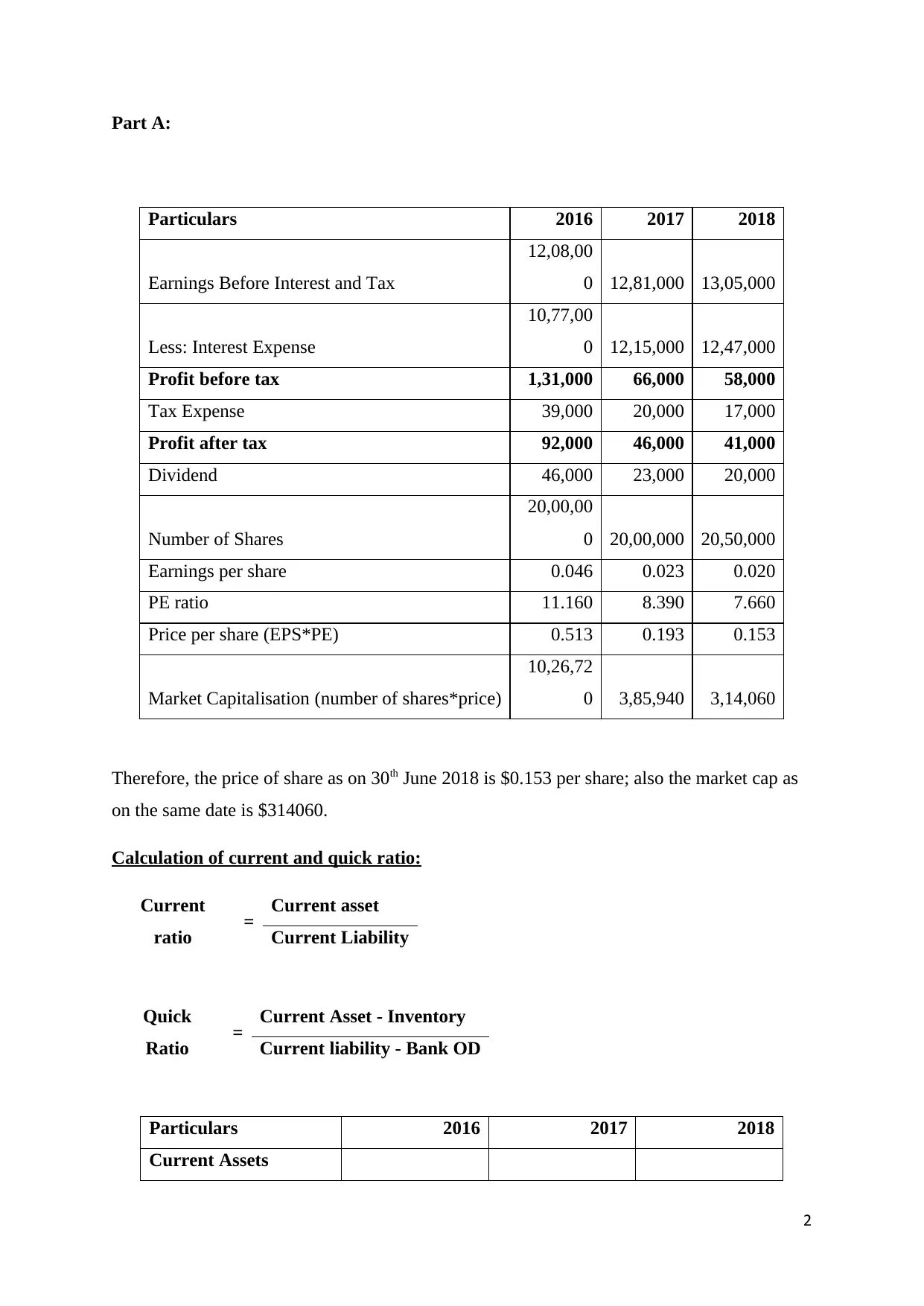
Part A:
Particulars 2016 2017 2018
Earnings Before Interest and Tax
12,08,00
0 12,81,000 13,05,000
Less: Interest Expense
10,77,00
0 12,15,000 12,47,000
Profit before tax 1,31,000 66,000 58,000
Tax Expense 39,000 20,000 17,000
Profit after tax 92,000 46,000 41,000
Dividend 46,000 23,000 20,000
Number of Shares
20,00,00
0 20,00,000 20,50,000
Earnings per share 0.046 0.023 0.020
PE ratio 11.160 8.390 7.660
Price per share (EPS*PE) 0.513 0.193 0.153
Market Capitalisation (number of shares*price)
10,26,72
0 3,85,940 3,14,060
Therefore, the price of share as on 30th June 2018 is $0.153 per share; also the market cap as
on the same date is $314060.
Calculation of current and quick ratio:
Current
ratio = Current asset
Current Liability
Quick
Ratio = Current Asset - Inventory
Current liability - Bank OD
Particulars 2016 2017 2018
Current Assets
2
Particulars 2016 2017 2018
Earnings Before Interest and Tax
12,08,00
0 12,81,000 13,05,000
Less: Interest Expense
10,77,00
0 12,15,000 12,47,000
Profit before tax 1,31,000 66,000 58,000
Tax Expense 39,000 20,000 17,000
Profit after tax 92,000 46,000 41,000
Dividend 46,000 23,000 20,000
Number of Shares
20,00,00
0 20,00,000 20,50,000
Earnings per share 0.046 0.023 0.020
PE ratio 11.160 8.390 7.660
Price per share (EPS*PE) 0.513 0.193 0.153
Market Capitalisation (number of shares*price)
10,26,72
0 3,85,940 3,14,060
Therefore, the price of share as on 30th June 2018 is $0.153 per share; also the market cap as
on the same date is $314060.
Calculation of current and quick ratio:
Current
ratio = Current asset
Current Liability
Quick
Ratio = Current Asset - Inventory
Current liability - Bank OD
Particulars 2016 2017 2018
Current Assets
2
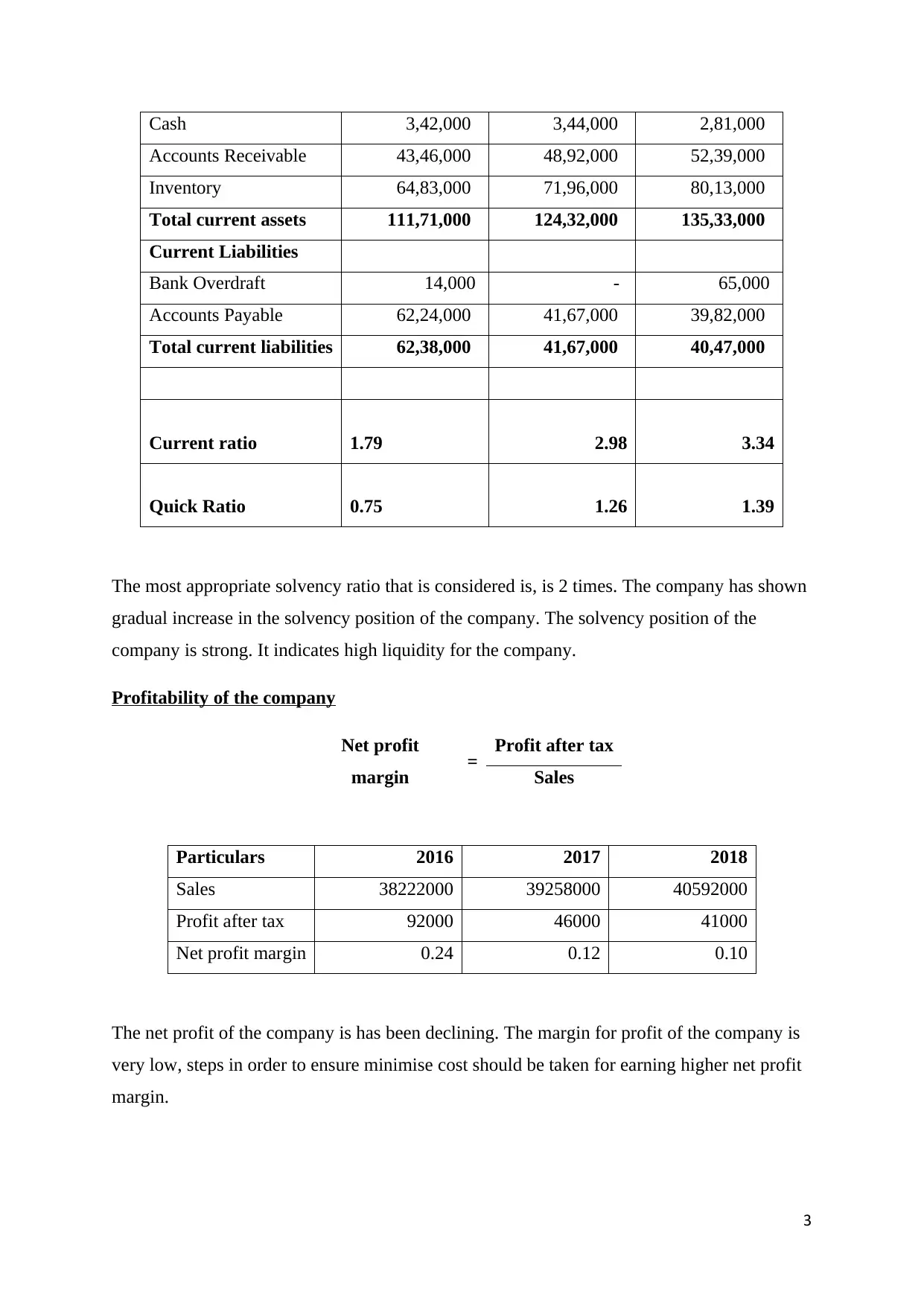
Cash 3,42,000 3,44,000 2,81,000
Accounts Receivable 43,46,000 48,92,000 52,39,000
Inventory 64,83,000 71,96,000 80,13,000
Total current assets 111,71,000 124,32,000 135,33,000
Current Liabilities
Bank Overdraft 14,000 - 65,000
Accounts Payable 62,24,000 41,67,000 39,82,000
Total current liabilities 62,38,000 41,67,000 40,47,000
Current ratio 1.79 2.98 3.34
Quick Ratio 0.75 1.26 1.39
The most appropriate solvency ratio that is considered is, is 2 times. The company has shown
gradual increase in the solvency position of the company. The solvency position of the
company is strong. It indicates high liquidity for the company.
Profitability of the company
Net profit
margin = Profit after tax
Sales
Particulars 2016 2017 2018
Sales 38222000 39258000 40592000
Profit after tax 92000 46000 41000
Net profit margin 0.24 0.12 0.10
The net profit of the company is has been declining. The margin for profit of the company is
very low, steps in order to ensure minimise cost should be taken for earning higher net profit
margin.
3
Accounts Receivable 43,46,000 48,92,000 52,39,000
Inventory 64,83,000 71,96,000 80,13,000
Total current assets 111,71,000 124,32,000 135,33,000
Current Liabilities
Bank Overdraft 14,000 - 65,000
Accounts Payable 62,24,000 41,67,000 39,82,000
Total current liabilities 62,38,000 41,67,000 40,47,000
Current ratio 1.79 2.98 3.34
Quick Ratio 0.75 1.26 1.39
The most appropriate solvency ratio that is considered is, is 2 times. The company has shown
gradual increase in the solvency position of the company. The solvency position of the
company is strong. It indicates high liquidity for the company.
Profitability of the company
Net profit
margin = Profit after tax
Sales
Particulars 2016 2017 2018
Sales 38222000 39258000 40592000
Profit after tax 92000 46000 41000
Net profit margin 0.24 0.12 0.10
The net profit of the company is has been declining. The margin for profit of the company is
very low, steps in order to ensure minimise cost should be taken for earning higher net profit
margin.
3
⊘ This is a preview!⊘
Do you want full access?
Subscribe today to unlock all pages.

Trusted by 1+ million students worldwide
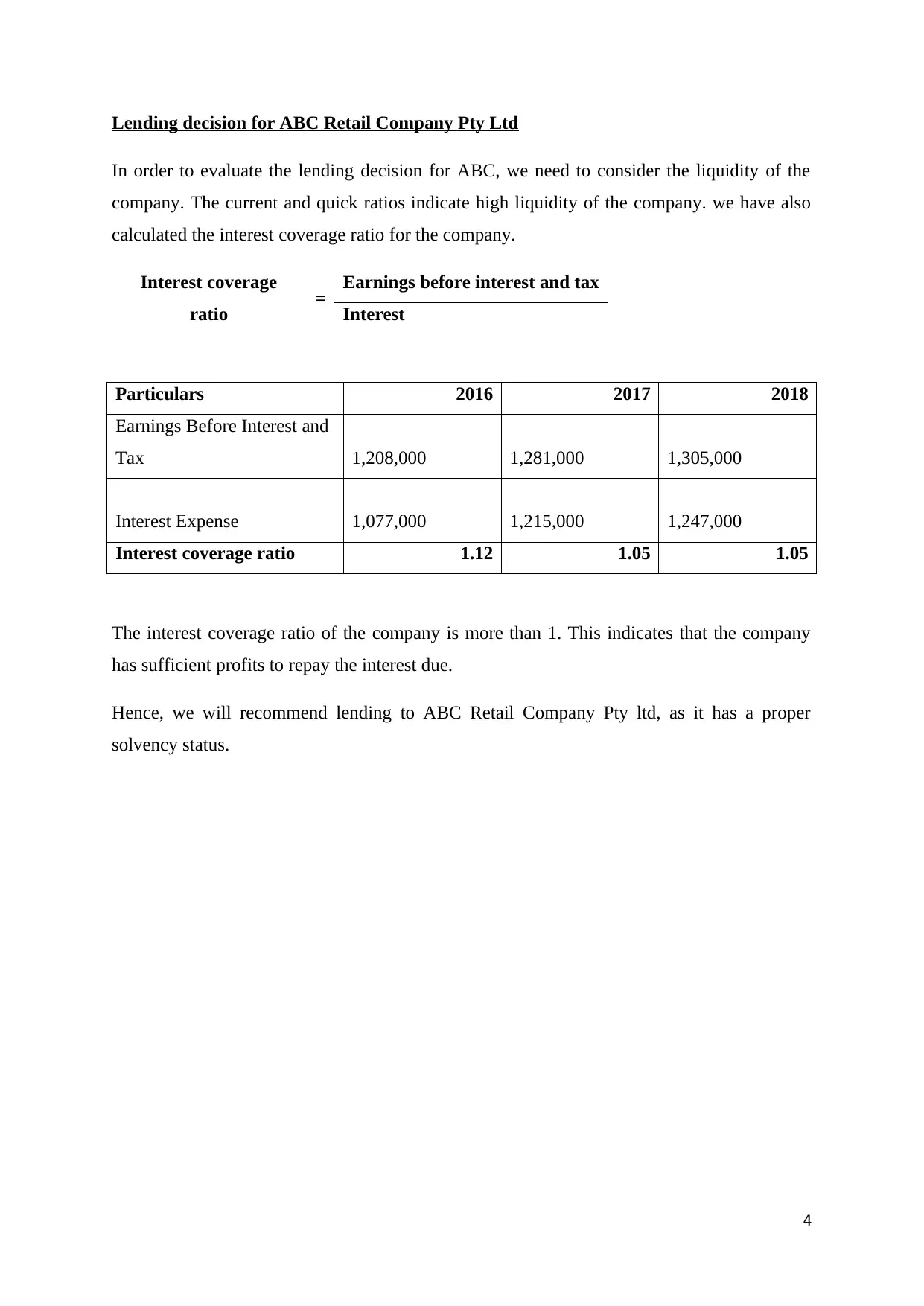
Lending decision for ABC Retail Company Pty Ltd
In order to evaluate the lending decision for ABC, we need to consider the liquidity of the
company. The current and quick ratios indicate high liquidity of the company. we have also
calculated the interest coverage ratio for the company.
Interest coverage
ratio = Earnings before interest and tax
Interest
Particulars 2016 2017 2018
Earnings Before Interest and
Tax 1,208,000 1,281,000 1,305,000
Interest Expense 1,077,000 1,215,000 1,247,000
Interest coverage ratio 1.12 1.05 1.05
The interest coverage ratio of the company is more than 1. This indicates that the company
has sufficient profits to repay the interest due.
Hence, we will recommend lending to ABC Retail Company Pty ltd, as it has a proper
solvency status.
4
In order to evaluate the lending decision for ABC, we need to consider the liquidity of the
company. The current and quick ratios indicate high liquidity of the company. we have also
calculated the interest coverage ratio for the company.
Interest coverage
ratio = Earnings before interest and tax
Interest
Particulars 2016 2017 2018
Earnings Before Interest and
Tax 1,208,000 1,281,000 1,305,000
Interest Expense 1,077,000 1,215,000 1,247,000
Interest coverage ratio 1.12 1.05 1.05
The interest coverage ratio of the company is more than 1. This indicates that the company
has sufficient profits to repay the interest due.
Hence, we will recommend lending to ABC Retail Company Pty ltd, as it has a proper
solvency status.
4
Paraphrase This Document
Need a fresh take? Get an instant paraphrase of this document with our AI Paraphraser
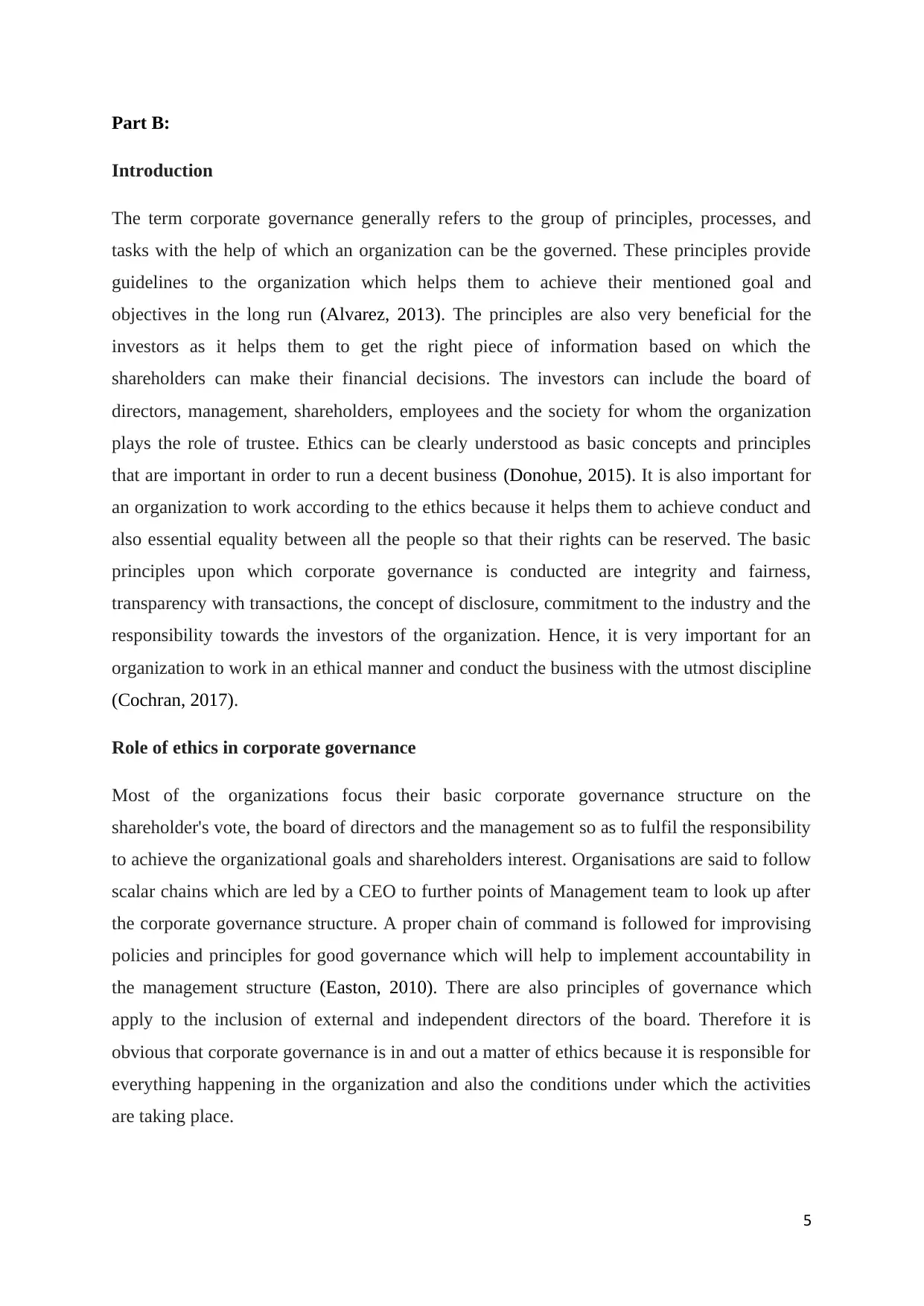
Part B:
Introduction
The term corporate governance generally refers to the group of principles, processes, and
tasks with the help of which an organization can be the governed. These principles provide
guidelines to the organization which helps them to achieve their mentioned goal and
objectives in the long run (Alvarez, 2013). The principles are also very beneficial for the
investors as it helps them to get the right piece of information based on which the
shareholders can make their financial decisions. The investors can include the board of
directors, management, shareholders, employees and the society for whom the organization
plays the role of trustee. Ethics can be clearly understood as basic concepts and principles
that are important in order to run a decent business (Donohue, 2015). It is also important for
an organization to work according to the ethics because it helps them to achieve conduct and
also essential equality between all the people so that their rights can be reserved. The basic
principles upon which corporate governance is conducted are integrity and fairness,
transparency with transactions, the concept of disclosure, commitment to the industry and the
responsibility towards the investors of the organization. Hence, it is very important for an
organization to work in an ethical manner and conduct the business with the utmost discipline
(Cochran, 2017).
Role of ethics in corporate governance
Most of the organizations focus their basic corporate governance structure on the
shareholder's vote, the board of directors and the management so as to fulfil the responsibility
to achieve the organizational goals and shareholders interest. Organisations are said to follow
scalar chains which are led by a CEO to further points of Management team to look up after
the corporate governance structure. A proper chain of command is followed for improvising
policies and principles for good governance which will help to implement accountability in
the management structure (Easton, 2010). There are also principles of governance which
apply to the inclusion of external and independent directors of the board. Therefore it is
obvious that corporate governance is in and out a matter of ethics because it is responsible for
everything happening in the organization and also the conditions under which the activities
are taking place.
5
Introduction
The term corporate governance generally refers to the group of principles, processes, and
tasks with the help of which an organization can be the governed. These principles provide
guidelines to the organization which helps them to achieve their mentioned goal and
objectives in the long run (Alvarez, 2013). The principles are also very beneficial for the
investors as it helps them to get the right piece of information based on which the
shareholders can make their financial decisions. The investors can include the board of
directors, management, shareholders, employees and the society for whom the organization
plays the role of trustee. Ethics can be clearly understood as basic concepts and principles
that are important in order to run a decent business (Donohue, 2015). It is also important for
an organization to work according to the ethics because it helps them to achieve conduct and
also essential equality between all the people so that their rights can be reserved. The basic
principles upon which corporate governance is conducted are integrity and fairness,
transparency with transactions, the concept of disclosure, commitment to the industry and the
responsibility towards the investors of the organization. Hence, it is very important for an
organization to work in an ethical manner and conduct the business with the utmost discipline
(Cochran, 2017).
Role of ethics in corporate governance
Most of the organizations focus their basic corporate governance structure on the
shareholder's vote, the board of directors and the management so as to fulfil the responsibility
to achieve the organizational goals and shareholders interest. Organisations are said to follow
scalar chains which are led by a CEO to further points of Management team to look up after
the corporate governance structure. A proper chain of command is followed for improvising
policies and principles for good governance which will help to implement accountability in
the management structure (Easton, 2010). There are also principles of governance which
apply to the inclusion of external and independent directors of the board. Therefore it is
obvious that corporate governance is in and out a matter of ethics because it is responsible for
everything happening in the organization and also the conditions under which the activities
are taking place.
5
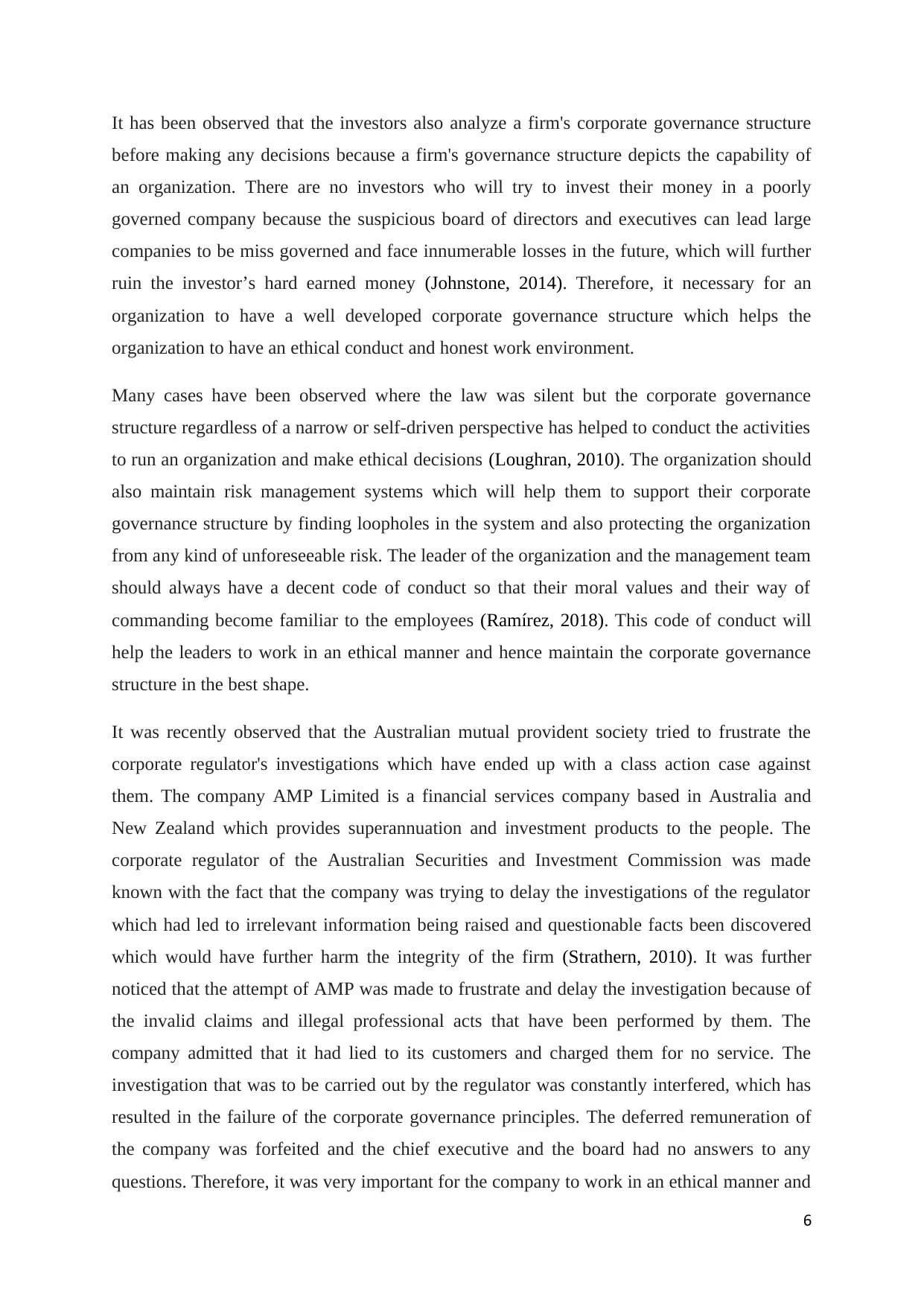
It has been observed that the investors also analyze a firm's corporate governance structure
before making any decisions because a firm's governance structure depicts the capability of
an organization. There are no investors who will try to invest their money in a poorly
governed company because the suspicious board of directors and executives can lead large
companies to be miss governed and face innumerable losses in the future, which will further
ruin the investor’s hard earned money (Johnstone, 2014). Therefore, it necessary for an
organization to have a well developed corporate governance structure which helps the
organization to have an ethical conduct and honest work environment.
Many cases have been observed where the law was silent but the corporate governance
structure regardless of a narrow or self-driven perspective has helped to conduct the activities
to run an organization and make ethical decisions (Loughran, 2010). The organization should
also maintain risk management systems which will help them to support their corporate
governance structure by finding loopholes in the system and also protecting the organization
from any kind of unforeseeable risk. The leader of the organization and the management team
should always have a decent code of conduct so that their moral values and their way of
commanding become familiar to the employees (Ramírez, 2018). This code of conduct will
help the leaders to work in an ethical manner and hence maintain the corporate governance
structure in the best shape.
It was recently observed that the Australian mutual provident society tried to frustrate the
corporate regulator's investigations which have ended up with a class action case against
them. The company AMP Limited is a financial services company based in Australia and
New Zealand which provides superannuation and investment products to the people. The
corporate regulator of the Australian Securities and Investment Commission was made
known with the fact that the company was trying to delay the investigations of the regulator
which had led to irrelevant information being raised and questionable facts been discovered
which would have further harm the integrity of the firm (Strathern, 2010). It was further
noticed that the attempt of AMP was made to frustrate and delay the investigation because of
the invalid claims and illegal professional acts that have been performed by them. The
company admitted that it had lied to its customers and charged them for no service. The
investigation that was to be carried out by the regulator was constantly interfered, which has
resulted in the failure of the corporate governance principles. The deferred remuneration of
the company was forfeited and the chief executive and the board had no answers to any
questions. Therefore, it was very important for the company to work in an ethical manner and
6
before making any decisions because a firm's governance structure depicts the capability of
an organization. There are no investors who will try to invest their money in a poorly
governed company because the suspicious board of directors and executives can lead large
companies to be miss governed and face innumerable losses in the future, which will further
ruin the investor’s hard earned money (Johnstone, 2014). Therefore, it necessary for an
organization to have a well developed corporate governance structure which helps the
organization to have an ethical conduct and honest work environment.
Many cases have been observed where the law was silent but the corporate governance
structure regardless of a narrow or self-driven perspective has helped to conduct the activities
to run an organization and make ethical decisions (Loughran, 2010). The organization should
also maintain risk management systems which will help them to support their corporate
governance structure by finding loopholes in the system and also protecting the organization
from any kind of unforeseeable risk. The leader of the organization and the management team
should always have a decent code of conduct so that their moral values and their way of
commanding become familiar to the employees (Ramírez, 2018). This code of conduct will
help the leaders to work in an ethical manner and hence maintain the corporate governance
structure in the best shape.
It was recently observed that the Australian mutual provident society tried to frustrate the
corporate regulator's investigations which have ended up with a class action case against
them. The company AMP Limited is a financial services company based in Australia and
New Zealand which provides superannuation and investment products to the people. The
corporate regulator of the Australian Securities and Investment Commission was made
known with the fact that the company was trying to delay the investigations of the regulator
which had led to irrelevant information being raised and questionable facts been discovered
which would have further harm the integrity of the firm (Strathern, 2010). It was further
noticed that the attempt of AMP was made to frustrate and delay the investigation because of
the invalid claims and illegal professional acts that have been performed by them. The
company admitted that it had lied to its customers and charged them for no service. The
investigation that was to be carried out by the regulator was constantly interfered, which has
resulted in the failure of the corporate governance principles. The deferred remuneration of
the company was forfeited and the chief executive and the board had no answers to any
questions. Therefore, it was very important for the company to work in an ethical manner and
6
⊘ This is a preview!⊘
Do you want full access?
Subscribe today to unlock all pages.

Trusted by 1+ million students worldwide
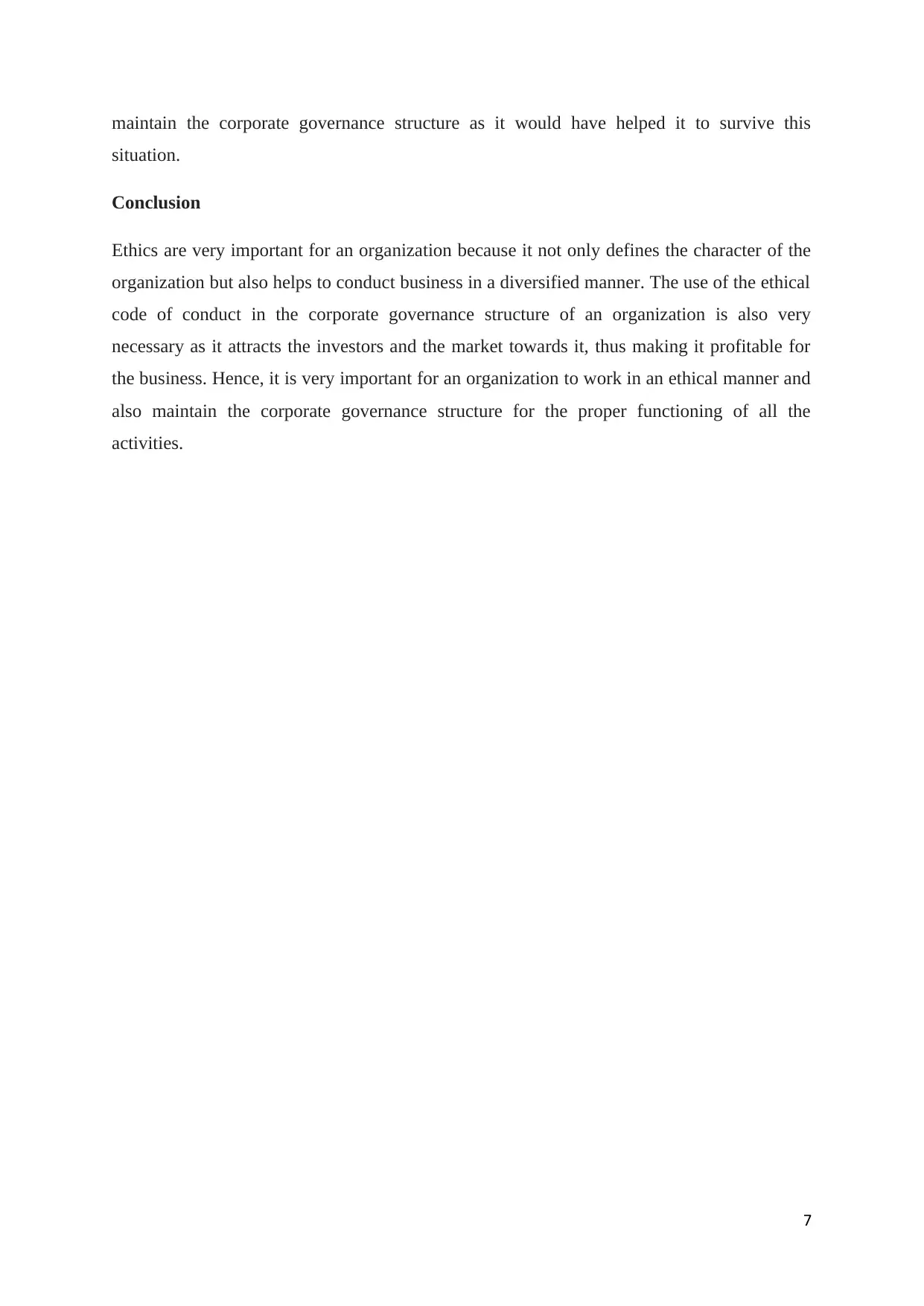
maintain the corporate governance structure as it would have helped it to survive this
situation.
Conclusion
Ethics are very important for an organization because it not only defines the character of the
organization but also helps to conduct business in a diversified manner. The use of the ethical
code of conduct in the corporate governance structure of an organization is also very
necessary as it attracts the investors and the market towards it, thus making it profitable for
the business. Hence, it is very important for an organization to work in an ethical manner and
also maintain the corporate governance structure for the proper functioning of all the
activities.
7
situation.
Conclusion
Ethics are very important for an organization because it not only defines the character of the
organization but also helps to conduct business in a diversified manner. The use of the ethical
code of conduct in the corporate governance structure of an organization is also very
necessary as it attracts the investors and the market towards it, thus making it profitable for
the business. Hence, it is very important for an organization to work in an ethical manner and
also maintain the corporate governance structure for the proper functioning of all the
activities.
7
Paraphrase This Document
Need a fresh take? Get an instant paraphrase of this document with our AI Paraphraser
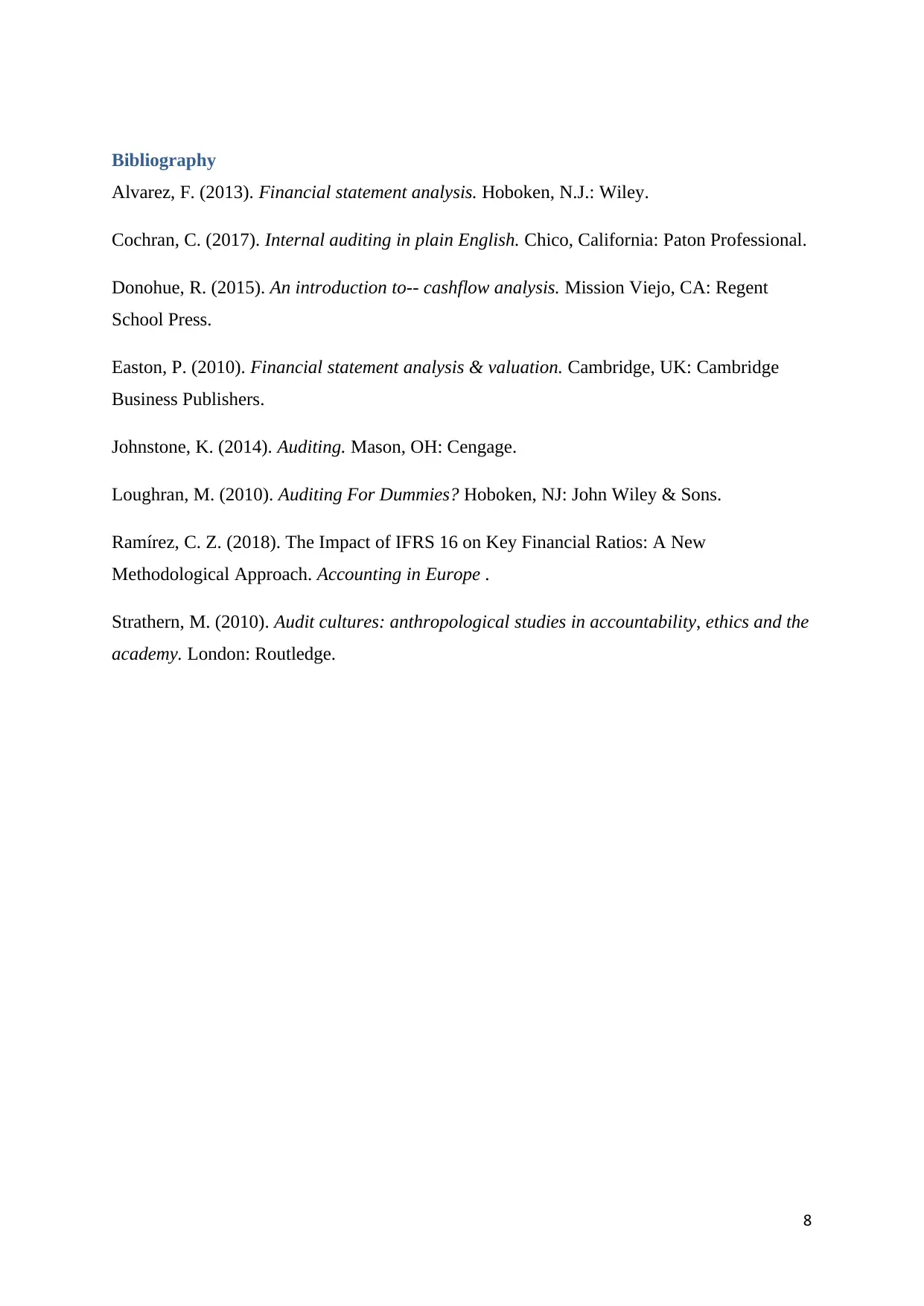
Bibliography
Alvarez, F. (2013). Financial statement analysis. Hoboken, N.J.: Wiley.
Cochran, C. (2017). Internal auditing in plain English. Chico, California: Paton Professional.
Donohue, R. (2015). An introduction to-- cashflow analysis. Mission Viejo, CA: Regent
School Press.
Easton, P. (2010). Financial statement analysis & valuation. Cambridge, UK: Cambridge
Business Publishers.
Johnstone, K. (2014). Auditing. Mason, OH: Cengage.
Loughran, M. (2010). Auditing For Dummies? Hoboken, NJ: John Wiley & Sons.
Ramírez, C. Z. (2018). The Impact of IFRS 16 on Key Financial Ratios: A New
Methodological Approach. Accounting in Europe .
Strathern, M. (2010). Audit cultures: anthropological studies in accountability, ethics and the
academy. London: Routledge.
8
Alvarez, F. (2013). Financial statement analysis. Hoboken, N.J.: Wiley.
Cochran, C. (2017). Internal auditing in plain English. Chico, California: Paton Professional.
Donohue, R. (2015). An introduction to-- cashflow analysis. Mission Viejo, CA: Regent
School Press.
Easton, P. (2010). Financial statement analysis & valuation. Cambridge, UK: Cambridge
Business Publishers.
Johnstone, K. (2014). Auditing. Mason, OH: Cengage.
Loughran, M. (2010). Auditing For Dummies? Hoboken, NJ: John Wiley & Sons.
Ramírez, C. Z. (2018). The Impact of IFRS 16 on Key Financial Ratios: A New
Methodological Approach. Accounting in Europe .
Strathern, M. (2010). Audit cultures: anthropological studies in accountability, ethics and the
academy. London: Routledge.
8
1 out of 8
Related Documents
Your All-in-One AI-Powered Toolkit for Academic Success.
+13062052269
info@desklib.com
Available 24*7 on WhatsApp / Email
![[object Object]](/_next/static/media/star-bottom.7253800d.svg)
Unlock your academic potential
Copyright © 2020–2025 A2Z Services. All Rights Reserved. Developed and managed by ZUCOL.




